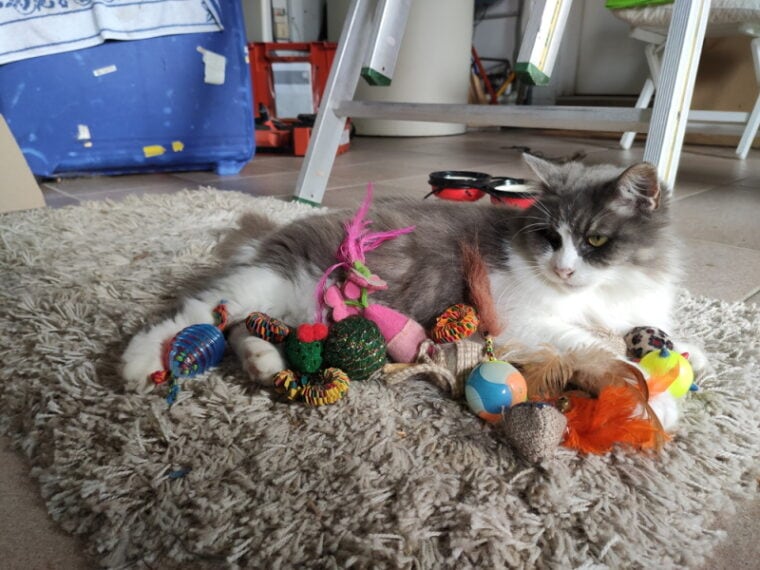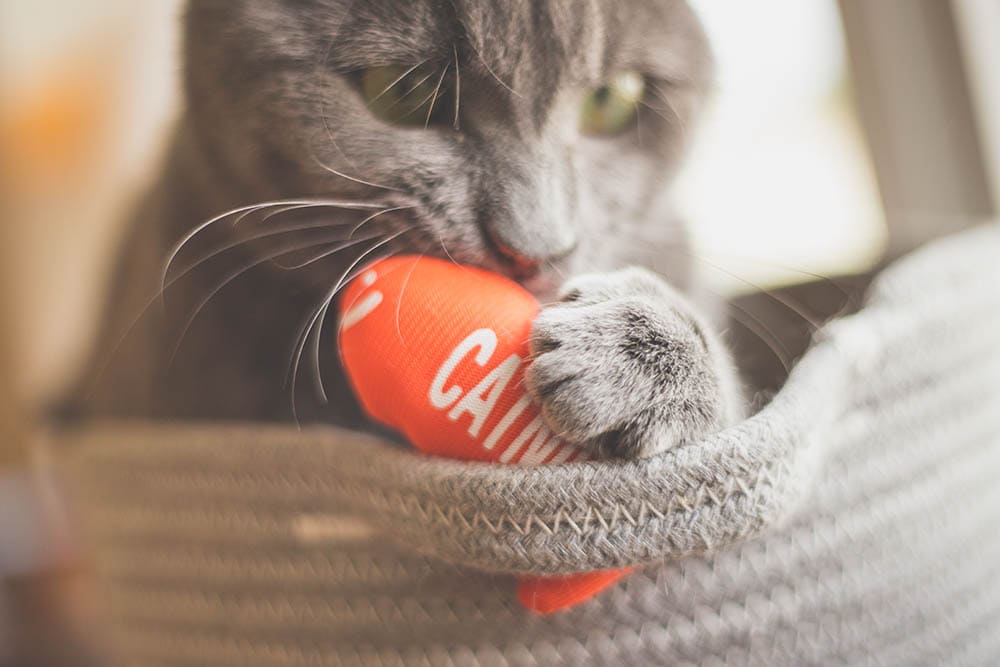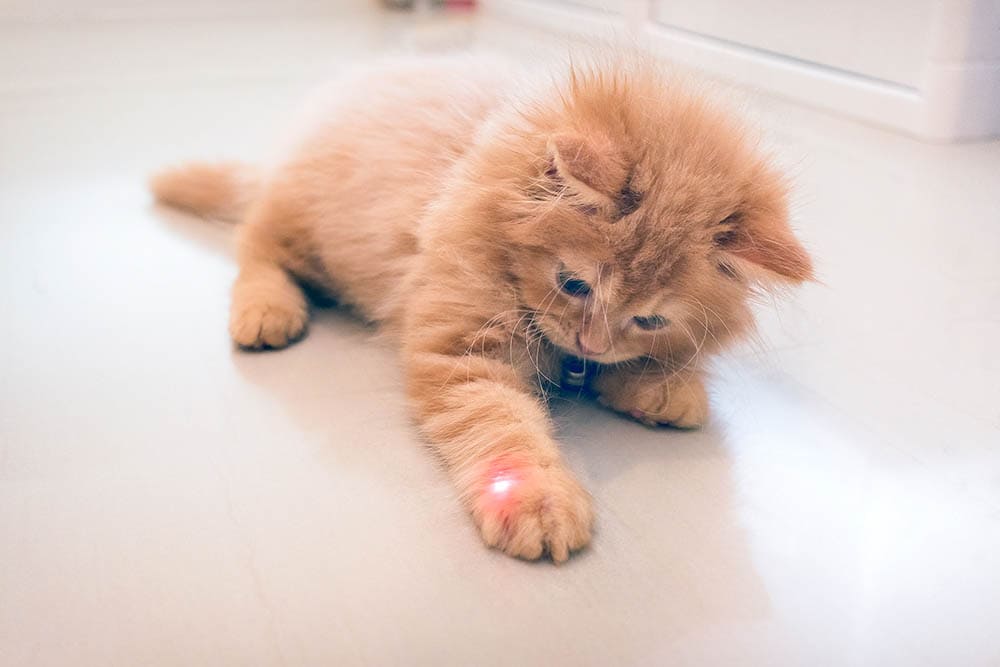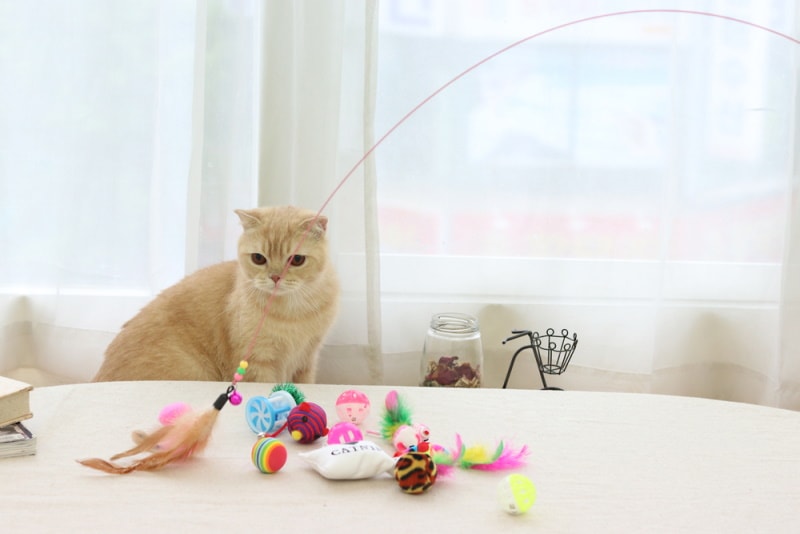
Cats are instinctive predators, and suitable cat toys can help them stay physically active and mentally sharp. Any toy your furball can stare at from a distance, stalk, and pounce on can give it hours of enjoyment and entertainment.
Have you just adopted a furry friend and want to strengthen a bond between you? Read on to learn about six types of cat toys that can turn your dull pet into a playful furball.
We will also discuss how to use these toys to keep your feline engaged. Our detailed breakdown will additionally provide tips for using cat toys during training sessions or managing behavioral problems.
The 6 Types of Cat Toys
1. Catnip Toys

If your cat gets bored of toys quickly or turns its head the other way each time you purchase a new toy, it’s time to try catnip toys. Most cats find catnip irresistible and will not just attack catnip toys but also toss them around, chew, and roll over with them. You could use these toys to take your play sessions a notch higher.
Playing with catnip toys for just a few minutes will ensure your furball enjoys a euphoric high for 5 to 15 minutes. After this, it will mellow out and possibly take a nap.
Catnip can really enrich your cat's life, especially if you choose a fun, well-built catnip toy. Our favorite option is Hepper's Catnip Stick Toy, which offers sturdy construction, 100% organic catnip fill, and a great range of colors. These toys are handmade in the USA and feature bite-proof double bagging.
At Pet Keen, we've admired Hepper for many years, and decided to take a controlling ownership interest so that we could benefit from the outstanding designs of this cool cat company!
2. Wand Toys

Wand toys or cat teasers are interactive toys that enchant cats. They consist of a pole, string, and an attachment toy at the end. These toys spark a cat’s instinct to hunt, as the attached toy serves as its prey.
Wand toys, apart from the all-in-one options, come with several attachments. Some brands offer as many as five to seven attachments allowing you to change your feline’s prey choices. If your cat loves hunting birds, a wand toy with a feathered attachment will do the trick!
3. Scratchers

Cats have a natural tendency to scratch. They can scratch your furniture, carpet, or drapery to sharpen their claws, relieve stress, and mark their territories. Also, they can scratch to give their backs a good stretch.
Unfortunately, you cannot train your cat, not to scratch. Your best bet is to direct the scratching to an acceptable area. A scratching toy is just what you need to ensure your furry friend can scratch to its heart’s content.
4. Cat Trees / Climbers

Cat trees, also known as cat climbers or climbing towers, target felines’ predatory and defensive instincts. Cats love climbing because a high position gives them an aerial advantage over their “prey.” Also, they love scratching to keep their claws sharp and ready to attack.
A cat tree can allow your furball to indulge in its hard-wired tendency to climb and scratch. Some structures feature hiding spots where your cat will also have a blast exploring.
5. Laser Toys

Laser toys are perfect for mental stimulation. The laser beam mimics fast-moving prey and will intensely engage your furry buddy as the tiny bright light bounces off the floor, walls, and the feline’s body.
The markets have parades of laser toys, and while some are for interactive play, you can find automatic laser toys ideal for solo play. Automatic laser toys create unpredictable paths to keep play sessions challenging and interesting. Be sure to preset the device to turn on and shut off after 15 to 30 minutes.
- Related Read: Why do Cats Love Lasers? 3 Reasons Why
6. Puzzle Toys

Cats are curious and love piecing up puzzles to figure out where you hide their food, how to sneak outdoors, and even how to get into the cat food cabinet. Moreover, it is common for cats to come up with unique games, including those that encourage undesirable behavior.
Puzzle toys provide mental stimulation by targeting your cat’s curiosity and hunting instincts. You can hide treats or catnip toys inside a puzzle and give your furry friend a few minutes to find a way to obtain their favorite goodies.
Tips for Using Cat Toys
FAQ
Cats are clever, curious, and playful. Cat toys can stimulate your furry friend physically and mentally by providing the opportunity for it to hunt, run and jump. Here are a few frequently asked questions about cat toys.
Is It Worth It to Invest in Cat Toys for My Furry Friend?
Cat toys provide mental stimulation and encourage felines to exercise and avoid gaining unhealthy weight. Moreover, toys provide a healthy and safe outlet for natural hunting and scratching instincts and can help address various behavioral problems. Investing in cat toys is worth it because playtime can reduce the risk of common feline illnesses like diabetes and obesity.
Which Are the Best Cat Toys?
In general, cat toys help to keep felines happy and healthy. The best toy for your furry friend will depend on its preferences and your goals. Different toys offer unique benefits, and investing in at least three types of toys is always ideal. For instance, a catnip toy can make a lazy couch potato more playful. On the other hand, interactive toys like wand toys can foster the bond between you and your pet

Which Are the Best Solo-Play Cat Toys?
Cats dislike staying at home alone with nothing to do. Often, they get into mischievous behaviors in a desperate attempt to kill boredom. If you are not around to interact with your pet, you should consider using puzzle toys, automatic laser toys, or scratchers. The best choice will also depend on your cat’s preferences.
How Often Should I Play With My Cat?
Cats have different needs and personalities, and it is perfectly okay to schedule play sessions based on your best judgment. Also, pet parents have varying schedules that may limit the amount of time they can engage their pets in interactive play. Generally, you should play with your cat for 5 to 30 minutes daily. Don’t make the sessions too short, and also avoid overstimulating your furball.
Why Does My Cat Not Like Its Toys?
Mastering your feline’s play style and preferences can be a bit of a learning curve. Identifying the cat toys your pet fancies may take trial and error. While some cats prefer toys that mimic prey movements or textures, others react better to toys that squeak, twitter or crackle when squeezed. Also, some cats are adventurous and prefer hiding games over hunting games.
Summary
Generally, most felines love toys that allow them to mimic predatory acts. Hunting is a natural instinct, and your furry buddy will enjoy invaluable entertainment as it explores a new plaything and then stalks, chases, pounces, captures, bites, carries, or rolls around with its “prey.”
In between play sessions, your cat may retreat with its head down and watch its toy from a distance. This merely implies that the game is at its climax. Your furry friend is simply resetting and creating a new strategy to attack!
Featured Image Credit: Darlow82, Shutterstock








